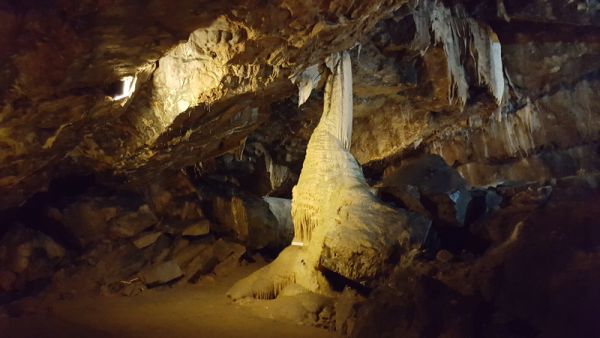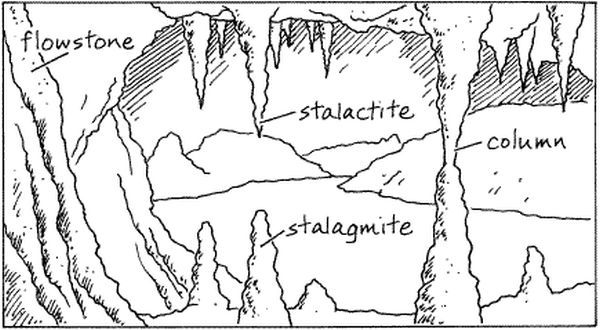
History
While the presence a cave has been known in the area for at least as far back as 1777, Mitchelstown Cave was discovered accidentally by Michael Condon, a farm worker on 3 May 1833. It was first explored and mapped in 1834 and subsequently visited by a large number of eminent naturalists and speleologists. In 1895 the fauna found within the cave was first described and in 1908 the cave was thoroughly explored and resurveyed.
Formation
A limestone cave or cavern like Mitchelstown Cave is a natural cavity that is formed underneath the Earth’s surface that can range from a few metres to many kilometres in length and depth. Most of the world’s caves are formed in porous limestone. Over millions of years, acidic groundwater or underground rivers dissolve away the limestone, leaving cavities which grow over time.
Dolomitic limestone, a sedimentary rock, was formed over millions of years through chemical reactions generated by single-celled, blue-green algae, called cyanobacteria.
As time passed the limestone, which is permeable and soluble, was eroded by water. Weak carbonic acid in rainwater, reacting with the chemicals in the rock, dissolved and eroded away the limestone as the water filtered into the underlying depths of sediments. Large hollow solution cavities were formed in the limestone in this way.
Beautiful Structures
Many beautiful structures – including stalagmites and stalactites – form inside caves as carbonic acid, carrying limestone, drips through cave roofs and onto their floors. Structures inside a cave may require millions of years to develop.

Flowstones are speleothems (deposits of calcium carbonate) on the walls or floor of a cave formed from a gradual flow of water over a relatively broad area.
The term stalactite comes from the Greek work stalaktos, which means “dripping”, because these other-worldly formations “drip” from the roofs of limestone caves. Essentially, water reacts with carbon-dioxide to form carbonic acid. It then seeps slowly through the roof of the cave, depositing calcium carbonate, which hardens and builds up over time to form a stalactite.
Stalagmites are corresponding formations on the floor of caves to stalactites. Stalagmites rise from the floor in a build-up of calcium carbonate over time, from mineral-bearing water dropped from the roof of the cave. The term stalagmite comes from the Greek word, stalagma, to “drop”.
Sometimes, stalactites and stalagmites meet, forming a pillar or column of rock-hard calcium carbonate.
To log this earthcache
Attention!!! !!! EarthCache Guideline Updated 10 June 2019 !!!
Please send the answers to the questions/tasks below to my mail account first. You can log immediately after. If something is wrong, I'll contact you. If no answers send before the log and no picture is attached to the log, your log will be deleted.
How is the cave build acidic groundwater or underground rivers?
Explain with your own words how you can discover this in the Mitchelstown Cave.
What type of Speleothem is the Tower of Babel in the Cave?
You will discover many Flowstone in the cave with lovely names. Name 3 of them you like most. And explain from your understanding why the flowstone is at this place build.
Take a picture of you or a personal object and your geocaching name / geocaching logo on a paper within the cave in background. Please upload the picture with the log. Do not bother editing picture with Photosphop or likewise, e.g. insert name in the image.
Enjoy the Cave and the Earthcache!